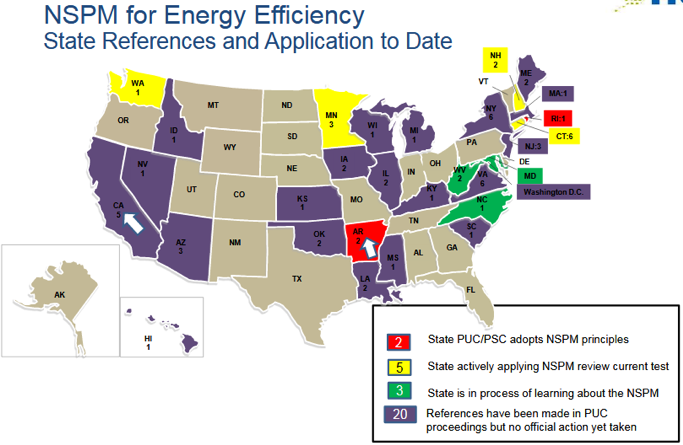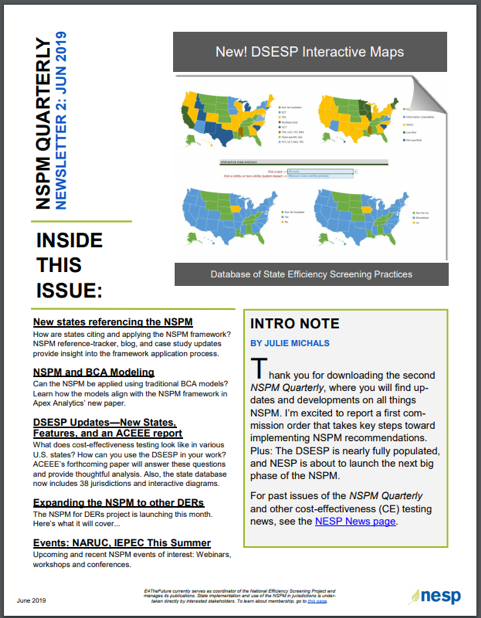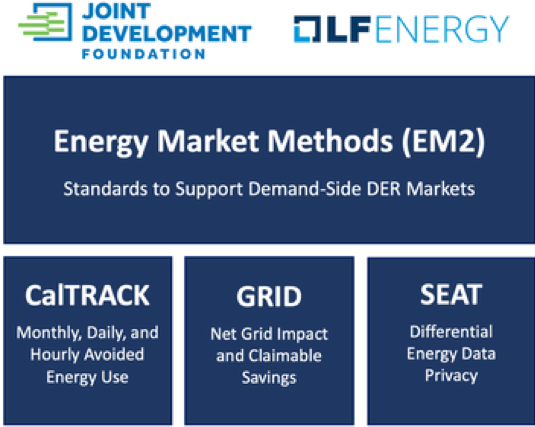Directors Note
Best wishes for a great summer. We were thrilled to see some of you at the Stellar EM&V annual public meeting in Providence in May. If you missed it, well, it covered a universe of topics, but slides are available and we invite you to read the first-hand account from our intern Alook. Please contact Elizabeth Titus or Giselle Procaccianti for more information on NEEP’s EM&V activities and related updates. We’d like to thank Claire Miziolek, former colleague, who has moved on to work for Massachusetts on planning for decarbonization, for her contributions over the years.
ISO-NE Forward Capacity Market Updates
This year, important issues surfaced at the ISO New England meeting regarding demand resource M&V requirements in the Forward Capacity Market. Spoiler alert – this is wonky but there are decisions pending so it’s good to be aware.
Proposal for reporting of EE Performance in All Hours (non-peak as well as peak). Resource scarcity conditions during the heat wave on Labor Day 2018 (an off-peak period) resulted in penalties for FCM participants. This prompted proposals to the NEPOOL Markets Committee. New England Power Generation Association (NEPGA) proposed that the demand resources (energy efficiency) should report its performance in all hours, instead of just for peak hours. The Demand Resources Working Group (DRWG), via a stakeholder process this spring, was tasked with studying how to do this. Findings were summarized in this initial draft report from ISO-NE on five options and their pros and cons. Only one option (Shaping Option A) meets the conditions of requiring no additional data, being low cost and relatively low effort for ISO-NE to implement. However, no consensus was reached on a recommendation. Other courses of action or the status quo may be also be under consideration. A final version of the report will be delivered to the NEPOOL Markets Committee for its deliberations later this summer, likely July 9-10. NEEP, E4TheFuture, and Advanced Energy Economy (AEE) are working closely with Eversource, National Grid, and others, monitoring and participating in the discussions to help keep the region’s stakeholders updated, as the outcome could impact the degree of risk energy efficiency participants face in the Forward Capacity Market. ISO-NE will likely post comments on the draft before July 1 and will provide materials for the NEPOOL Markets Committee meeting July 8-9.
Energy Efficiency program participation in the Forward Capacity Market has contributed to flattening the capacity demand trend in the region and it has contributed funding that advances the delivery of energy efficiency in the region.1
Net vs Gross Savings. Late last year, ISO-NE floated a proposal to report net rather than adjusted gross impacts of demand resources into the Forward Capacity Market. (Net impacts account for behavioral influences, free-ridership and spillover; more information on this is available from NEEP guidance). This caused concern for energy efficiency stakeholders for many reasons, including introducing uncertainty, creating the potential for reduced impacts, and the lack of a formal review process, as noted by Utility Dive. In response to a petition for declaratory order filed with FERC, by many concerned stakeholders, FERC ruled that such an order was not necessary, based on comments to petition in which ISO-NE stated it would not make changes to the measurement and verification process for energy efficiency resources without following the usual stakeholder process and filing the changes with FERC. This positive outcome brings needed clarity and certainty for energy efficiency resource providers in the region, ensuing that the value of their resources will not be unilaterally altered by ISO-NE without further process and FERC review. However, it is important to be aware of this issue because it reveals ISO-NE concerns about how to value energy efficiency from market transformation.
Sowing the Seeds of Change in Cost-Effectiveness
Two years ago, the National Standard Practice Manual (NSPM) debuted and began to bloom. The NSPM provides a comprehensive framework for cost-effectiveness assessment of energy resources. The manual describes principles, concepts, and methodologies for sound, balanced assessment of resource cost-effectiveness. E4TheFuture recently asked NEEP and other regional energy efficiency organizations (REEOs) for their key insights on use of the NSPM in their region, specifically around state knowledge, interest, engagement, and use.
Arkansas, Minnesota, and Rhode Island stand out as highly engaged, while several other states in the country are discussing principles or investigating non-energy impacts. Read this blog to find out more.

E4TheFuture just released the second quarterly NSPM newsletter (in case you missed the first, you can find it here)! NSPM Quarterly is chock full of essential news, events, and resources. In this quarter’s edition, you’ll find significant news about the Database of State Efficiency Screening Practices (DSESP). The newsletter previews an ACEEE topic brief that summarizes how the DSESP supports stakeholder understanding and input into cost-effectiveness testing processes. It also offers analysis of certain impacts accounted for in different state tests, with suggestions for how stakeholders can use the DSESP to support improving cost-effectiveness practices in their jurisdictions.
Take a look at the newsletter here and email NSPM@nationalefficiencyscreening.org to receive the free newsletter.
E4TheFuture is planning to build on the NSPM in 2020 to include consideration of distributed energy resources (DERs). The expanded NSPM will address benefit-cost analysis for DERs beyond energy efficiency, including distributed generation, demand response, storage and electric vehicles. See E4TheFuture’s presentation from NEEP’s recent meeting for more information.

Open Sesame: Software Protocols on the Move
The universe of software services for analyzing energy consumption data continues to expand. Will Advanced M&V tools - buildings analytics software - occupy a small niche in the energy program evaluation, measurement, and verification ecosystem or will they eventually dominate? Protocols build credibility and transparency and acceptance for EM&V tools and methods; they will help determine the fate of buildings analytics software tools. Suffice to say, there has been a lot of protocol-related activity within the past year, and since this amounts to a dizzying pace in the protocols world, here is an alphabet soup of some of the protocol sources.
ASHRAE – American Society of Heating, Refrigeration and Air-Conditioning Engineers is an international membership organization for buildings professionals with committees that develop or update standards. These include metrics to assess performance and acceptance criteria for models of building energy consumption. Evaluators, designers, researchers, and program implementers all make use of these protocols.
CalTRACK – California’s weather-adjusted billing analysis yielding whole building site-level savings is a working group-driven organic process. Phase 5 (CalTRACK Version 3.0) started this year. It is a system of general methods, implementation rules, and detailed specification which provides 100 percent open source code. It is a rigorous means of maintaining accountability for savings achieved at the meter in the energy efficiency portfolio and it forms the basis for savings claims for the Pacific Gas and Electric’s Pay-For-Performance (P4P) programs in California.
Why CalTRACK? The motivation was to create a level playing field for an open market for software tools that contractors use to predict savings and deliver rebates to customers.
What is its relationship to evaluation? CalTRACK does not replace EM&V for ratepayer programs. PG&E programs using CalTRACK are subject to EM&V through the California Public Utilities Commission for validating savings claims to qualify for the utility performance incentive payment from the Commission. Advanced Home Upgrade is subject to the same EM&V rigor as in previous years, and the CPUC and PG&E have agreed in advance to a quasi experimental approach to EM&V for incentive payments based on net program performance. (The requirements for claimable savings may vary by jurisdiction in California).
EM2 - Energy Market Methods Consortium is a stakeholder organization governed by organizations using CalTRACK to deliver Pay-for-Performance programs and vendors payed on the basis of these results. Its broad mission is development of standards to support energy programs and distributed energy resource (DER) markets as illustrated below. This is one of several energy M&V projects now hosted by the Linux Foundation.

EVO – Efficiency Valuation Organization is an international non-profit whose mission is to ensure that the savings and impact of energy efficiency and sustainability projects are accurately measured and verified; this helps enable investment with confidence in energy efficiency. It provides widely known IPMVP energy-related protocols as well as financing protocols, training, and certifications. IPMVP protocols appear in the M&V manuals for the Forward Capacity Market of ISO-NE and of PJM, for example. EVO is staying highly relevant with some recent work, in particular:
- EVO’s IPMVP Committee is currently working on a number of exciting topics, including statistics and uncertainty, renewable applications (just released on April 6, 2017), M&V 2.0, mon-routine adjustments to models and relevant topics, and M&V for ESCOs, among others. The intent is to develop a series of resources and application guides that will support a core concepts document.
- More guidance is needed, including: “Ex-ante 2.0” and Baseline Adjustment Ratios
IPMVP – International Program Measurement and Verification Protocols are a product of EVO. Starting in 2014, they are published as the IPMVP Core Concepts. This document defines the commonly used terminology and guiding principles for applying M&V, describes the project framework in which M&V activities take place, and describes the contents and requirements of adherent M&V projects. It applies to a wide variety of facilities including existing and new buildings and industrial processes. The latest version is available for free on the EVO website.
LFE – LF Energy – A Linux Foundation Initiative – is a membership organization available to members of The Linux Foundation and free to non-profits and academic organizations subject to approval. It provides a neutral, collaborative environment to build the digital foundations that enable the “electrification of everything to scale” to transform the world’s relationship to energy. As of this year, LFE now hosts three projects described this newsletter on building energy consumption protocols: EM2, OpenEEmeter, and Open Energy Data Initiative.
NMEC – Normalized Metered Energy Consumption is a term created in 2015 as part of California AB 802 to describe a simplified means of counting energy efficiency savings in existing buildings.
Savings based on NMEC is similar to the IPMVP Option C Whole Facility Approach to measurement and verification. This approach uses empirical mdeling, such as statistical regression, to develop relationships between energy use and independent variables. These relationships are needed to “normalize” energy use.
The legislation described “metered” energy use and did not use limiting language such as whole-building in its description. With the availability of cheaper sensors, improved connectivity, and a greater prevalence of system-level data, we can apply NMEC methods at a more granular scale; building subsystems. This approach has several advantages; savings will be a larger portion of the measured energy use, savings are measured where they are achieved, and owners obtain more direct and actionable information about the performance of their systems. The axiom “you can’t manage what you don’t measure” is foundational with NMEC methods.
OpenEEmeter (renamed Recurve in May 2019) is a software platform powered by open source code written in Python. The open source nature of the software is a type of protocol, in that it helps ensure credibility of Recurve results and potential consistency of methods across organizations in the industry. Its purpose is to help energy efficiency interact optimally with other distributed resources. By enabling transparent and consistent measurement of the time and location impacts of saving energy, efficiency can be offered at scale to really be in the mix with the rest.
OEDI – Open Energy Data Initiative was initiated by NREL and is an LFEnergy Project for use by data scientists, utilities, energy companies, and other interested parties to analyze energy data, identify useful patterns, and share with others. Its goal is to improve and automate access of high value datasets across the U.S. The impact of this initiative will be a robust data lake to enable comprehensive data analysis, and a catalog of data from multiple hosting locations, including metadata, licensing, and provenance. Sample code snippets (Python Notebooks, SQL Statements) will demonstrate access and query capabilities. Agreements and relationships with cloud vendors will enable sustained data hosting solutions. Stakeholder engagement will inform and encourage collaboration.
Loadshape Project: National and Regional Opportunities
The U.S. Department of Energy has funded a project to develop end-use load profiles for the U.S. building stock and make them publicly available for the whole country. Loadshapes are the most essential data resource needed for understanding the time-sensitive value of energy efficiency because they can provide information about energy usage for every hour of every day of the year, either by end-use or at the whole-building level, depending on how they are measured. This enables system planners and program designers and policy makers to understand when peaks occur, what contributes to peak periods when power is most expensive to deliver, and how to design systems and programs optimally. By October 2021, the project intends to produce:
- Validated end-use load profiles for U.S. building stock at both aggregate and individual building scales
- Calibrated building stock end use models with ability to estimate EE/DR savings profiles for existing and emerging technologies
- Documentation of load profile use cases, critical gaps, model methodology, and user guide
Having full year profile (8760 hour) loadshapes for all relevant use cases in the country would be a huge boon to energy planning and to optimizing energy use and efficiency, especially since load profiles are typically expensive to develop and difficult to keep updated in a changing landscape with emerging use cases. More information on this project was provided at NEEP’s recent meeting and it is also available from the national labs, which are currently seeking existing loadshape data from program evaluations and other sources to assist in their project. NEEP is about to enter into contracts with Amplify MA, a Massachusetts Foundation, and NYSERDA which will help support the DOE project and will enable these states to better understand loadshape gaps and needs in these states.
New Resources
ISO 50001: 2011 to 2018 Transition Guide This new DOE Protocol Resource offers a detailed, section-by-section comparison of the differences between the 2011 and 2018 versions of ISO 50001. This guidance was jointly developed by U.S. DOE, Lawrence Berkeley National Laboratory, and the U.S. Technical Advisory Group to ISO TC 301 (ISO 50001 committee) that represents U.S. interests in the international development of ISO 50001. Learn about the US TAG to ISO TC 301 and contact TAG Administrator Deann Desai for more information.
IEPEC Webinars – Topics/Recordings include:
- Demand Savings from Smart Thermostats
- Energy Storage – Quantitative and Qualitative
- Behavior-based Programs
- NILM - Lessons Learned
- TOU – California Opt-In Pilot
- Changing Energy Landscape
Other New NEEP Resources
-
Readiness for Advanced M&V in the Northeast, May 2019.
-
Updated Residential Energy Efficiency Database (REED) -now includes 2017 data
-
Updated Advanced Building Analytics Tool List, May 2019
Mark Your Calendar
Upcoming Forum, NEEP, and other webinars and meetings of potential interest
-
IEPEC Evaluation Conference – Informing Innovation: August 20 - 22, 2019, Denver, CO
-
EPRI/NEEP/NESCAUM Symposium – Pathways to Decarbonization: August 27 – 29, 2019, Brooklyn, NY
1 This recent blog from CLF on FCA 13 is one case illustrating the value of energy efficiency and demand resources in the FCM
